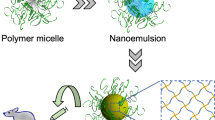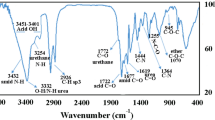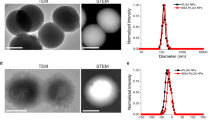Abstract
Nanoparticles (NPs) formulated using self-assembly of block copolymers have attracted significant attention as nano-scaled drug delivery vehicles. Here we report the development of a biodegradable NP using self-assembly of a linear amphiphilic block copolymer, Dex-b-PLA, composed of poly(D,L-lactide), and dextran. The size of the NPs can be precisely tuned between 15 and 70 nm by altering the molecular weight (M W) of the two polymer chains. Using doxorubicin as a model drug, we demonstrated that the NPs can carry up to 21% (w/w) of the drug payload. The release profile of doxorubicin from NPs showed sustained release for over 6 days. Using a rat model, we explored the pharmacokinetics profiles of Dex-b-PLA NPs, and showed proof-of-concept that long circulation lifetime of the NPs can be achieved by tuning the M W of Dex-b-PLA block copolymer. While the terminal half-life of Dex-b-PLA NPs (29.8 h) was similar to that observed in poly(ethylene glycol)-coated (PEG-coated) NPs (27.0 h), 90% of the injected Dex-b-PLA NPs were retained in the blood circulation for 38.3 h after injection, almost eight times longer than the PEG-coated NPs. The area under curve (AUC) of Dex-b-PLA NPs was almost four times higher than PEG-based NPs. The biodistribution study showed lower accumulation of Dex-b-PLA NPs in the spleen with 19.5% initial dose per gram tissue (IDGT) after 24 h compared to PEG-coated poly(lactide-co-glycolide) (PLGA) NPs (29.8% IDGT). These studies show that Dex-b-PLA block copolymer is a promising new biomaterial for making controlled nanoparticles as drug delivery vehicles.

Similar content being viewed by others
References
Jain, R. K.; Stylianopoulos, T. Delivering nanomedicine to solid tumors. Nat. Rev. Clin. Oncol. 2010, 7, 653–664.
Gu, F. X.; Karnik, R.; Wang, A. Z.; Alexis, F.; Levy-Nissenbaum, E.; Hong, S.; Langer, R. S.; Farokhzad, O. C. Targeted nanoparticles for cancer therapy. Nano Today 2007, 2, 14–21.
Pridgen, E. M.; Langer, R.; Farokhzad, O. C. Biodegradable, polymeric nanoparticle delivery systems for cancer therapy. Nanomedicine 2007, 2, 669–680.
Kim, D. K.; Dobson, J. Nanomedicine for targeted drug delivery. J. Mater. Chem. 2009, 19, 6294–6307.
Gref, R.; Minamitake, Y.; Peracchia, M. T.; Trubetskoy, V.; Torchilin, V.; Langer, R. Biodegradable long-circulating polymeric nanospheres. Science 1994, 263, 1600–1603.
Gaucher, G.; Marchessault, R. H.; Leroux, J. Polyester-based micelles and nanoparticles for the parenteral delivery of taxanes. J. Control. Release 2010, 143, 2–12.
Dong, Y.; Feng, S. In vitro and in vivo evaluation of methoxy polyethylene glycol-polylactide (MPEG-PLA) nanoparticles for small-molecule drug chemotherapy. Biomaterials 2007, 28, 4154–4160.
Gursahani, H.; Riggs-Sauthier, J.; Pfeiffer, J.; Lechuga-Ballesteros, D.; Fishburn, C. S. Absorption of polyethylene glycol (PEG) polymers: The effect of PEG size on permeability. J. Pharm. Sci. 2009, 98, 2847–2856.
Yang, J.; Cho, E.; Seo, S.; Lee, J.; Yoon, H.; Suh, J.; Huh, Y.; Haam, S. Enhancement of cellular binding efficiency and cytotoxicity using polyethylene glycol base triblock copolymeric nanoparticles for targeted drug delivery. J. Biomed. Mater. Res. A 2008, 84A, 273–280.
Wei, X.; Gong, C.; Gou, M.; Fu, S.; Guo, Q.; Shi, S.; Luo, F.; Guo, G.; Qiu, L.; Qian, Z. Biodegradable poly(ɛ-caprolactone)-poly(ethylene glycol) copolymers as drug delivery system. Int. J. Pharm. 2009, 381, 1–18.
Bazile, D.; Prudhomme, C.; Bassoullet, M. T.; Marlard, M.; Spenlehauer, G.; Veillard, M. Stealth Me.PEG-PLA nanoparticles avoid uptake by the mononuclear phagocytes system. J. Pharm. Sci. 1995, 84, 493–498.
Lemarchand, C.; Gref, R.; Couvreur, P. Polysaccharide-decorated nanoparticles. Eur. J. Pharm. Biopharm. 2004, 58, 327–341.
Kailasan, A.; Yuan, Q.; Yang, H. Synthesis and characterization of thermoresponsive polyamidoamine-polyethylene glycol-poly(D,L-lactide) core-shell nanoparticles. Acta Biomater. 2010, 6, 1131–1139.
Owens, D. E.; Peppas, N. A. Opsonization, biodistribution, and pharmacokinetics of polymeric nanoparticles. Int. J. Pharm. 2006, 307, 93–102.
Cho, K.; Wang, X.; Nie, S.; Chen, Z.; Shin, D. M. Therapeutic nanoparticles for drug delivery in cancer. Clin. Cancer Res. 2008, 14, 1310–1316.
Jiang, W.; Kim, B. Y. S.; Rutka, J. T.; Chan, W. C. W. Nanoparticle-mediated cellular response is size-dependent. Nat. Nanotechnol. 2008, 3, 145–150.
Karnik, R.; Gu, F.; Basto, P.; Cannizzaro, C.; Dean, L.; Kyei-Manu, W.; Langer, R.; Farokhzad, O. C. Microfluidic platform for controlled synthesis of polymeric nanoparticles. Nano Lett. 2008, 8, 2906–2912.
Goodwin, A. P.; Tabakman, S. M.; Welsher, K.; Sherlock, S. P.; Prencipe, G.; Dai, H. Phospholipid-dextran with a single coupling point: A useful amphiphile for functionalization of nanomaterials. J. Am. Chem. Soc. 2009, 131, 289–296.
Nouvel, C.; Frochot, C.; Sadtler, V.; Dubois, P.; Dellacherie, E.; Six, J. Polylactide-grafted dextrans: Synthesis and properties at interfaces and in solution. Macromolecules 2004, 37, 4981–4988.
Chittasupho, C.; Xie, S.; Baoum, A.; Yakovleva, T.; Siahaan, T. J.; Berkland, C. J. ICAM-1 targeting of doxorubicin-loaded PLGA nanoparticles to lung epithelial cells. Eur. J. Pharm. Sci. 2009, 37, 141–150.
Gu, F.; Zhang, L.; Teply, B. A.; Mann, N.; Wang, A.; Radovic-Moreno, A. F.; Langer, R.; Farokhzad, O. C. Precise engineering of targeted nanoparticles by using self-assembled biointegrated block copolymers. Proc. Natl. Acad. Sci. U. S. A. 2008, 105, 2586–2591.
Riley, T.; Govender, T.; Stolnik, S.; Xiong, C. D.; Garnett, M. C.; Illum, L.; Davis, S. S. Colloidal stability and drug incorporation aspects of micellar-like PLA-PEG nanoparticles. Colloids Surf. B-Biointerfaces. 1999, 19, 147–159.
Riley, T.; Stolnik, S.; Heald, C. R.; Xiong, C. D.; Garnett, M. C.; Illum, L.; Davis, S. S.; Purkiss, S. C.; Barlow, R. J.; Gellert, P. R. Physicochemical evaluation of nanoparticles assembled from poly(lactic acid)-poly(ethylene glycol) (PLA-PEG) block copolymers as drug delivery vehicles. Langmuir 2001, 17, 3168–3174.
Zahr, A. S.; Davis, C. A.; Pishko, M. V. Macrophage uptake of core-shell nanoparticles surface modified with poly(ethylene glycol). Langmuir 2006, 22, 8178–8185.
Dhar, S.; Gu, F. X.; Langer, R.; Farokhzad, O. C.; Lippard, S. J. Targeted delivery of cisplatin to prostate cancer cells by aptamer functionalized Pt(IV) prodrug-PLGA-PEG nanoparticles. Proc. Natl. Acad. Sci. U. S. A. 2008, 105, 17356–17361.
Shuai, X. T.; Ai, H.; Nasongkla, N.; Kim, S.; Gao, J. M. Micellar carriers based on block copolymers of poly(ɛ-caprolactone) and poly(ethylene glycol) for doxorubicin delivery. J. Control. Release 2004, 98, 415–426.
He, Y. Y.; Zhang, Y.; Gu, C. H.; Dai, W. F.; Lang, M. D. Micellar carrier based on methoxy poly(ethylene glycol)-block-poly(epsilon-caprolactone) block copolymers bearing ketone groups on the polyester block for doxorubicin delivery. J. Mater. Sci.-Mater. Med. 2010, 21, 567–574.
Missirlis, D.; Kawamura, R.; Tirelli, N.; Hubbell, J. A. Doxorubicin encapsulation and diffusional release from stable, polymeric, hydrogel nanoparticles. Eur. J. Pharm. Sci. 2006, 29, 120–129.
Kataoka, K.; Harada, A.; Nagasaki, Y. Block copolymer micelles for drug delivery: Design, characterization and biological significance. Adv. Drug Deliv. Rev. 2001, 47, 113–131.
Alpert, A. J. Hydrophilic-interaction chromatography for the separation of peptides, nucleic acids and other polar compounds. J. Chromatogr. A 1990, 499, 177–196.
Drummond, D. C.; Meyer, O.; Hong, K.; Kirpotin, D. B.; Papahadjopoulos, D. Optimizing liposomes for delivery of chemotherapeutic agents to solid tumors. Pharmacol. Rev. 1999, 51, 691–744.
Safra, T.; Muggia, F.; Jeffers, S.; Tsao-Wei, D. D.; Groshen, S.; Lyass, O.; Henderson, R.; Berry, G.; Gabizon, A. Pegylated liposomal doxorubicin (doxil): Reduced clinical cardiotoxicity in patients reaching or exceeding cumulative doses of 500 mg/m2. Ann. Oncol. 2000, 11, 1029–1033.
Magenheim, B.; Levy, M. Y.; Benita, S. A new in vitro technique for the evaluation of drugrelease profile from colloidal carriers-ultrafiltration technique at lowpressure. Int. J. Pharm. 1993, 94, 115–123.
Esmaeili, F.; Ghahremani, M. H.; Ostad, S. N.; Atyabi, F.; Seyedabadi, M.; Malekshahi, M. R.; Amini, M.; Dinarvand, R. Folate-receptor-targeted delivery of docetaxel nanoparticles prepared by PLGA-PEG-folate conjugate. J. Drug Target. 2008, 16, 415–423.
Dobrovoiskaia, M. A.; Clogston, J. D.; Neun, B. W.; Hall, J. B.; Patri, A. K.; McNeil, S. E. Method for analysis of nanoparticle hemolytic properties in vitro. Nano Lett. 2008, 8, 2180–2187.
Kim, D.; El-Shall, H.; Dennis, D.; Morey, T. Interaction of PLGA nanoparticles with human blood constituents. Colloid Surf. B-Biointerfaces 2005, 40, 83–91.
Fischer, D.; Li, Y. X.; Ahlemeyer, B.; Krieglstein, J.; Kissel, T. In vitro cytotoxicity testing of polycations: Influence of polymer structure on cell viability and hemolysis. Biomaterials 2003, 24, 1121–1131.
Sacco, J. J.; Botten, J.; Macbeth, F.; Bagust, A.; Clark, P. The average body surface area of adult cancer patients in the UK: A multicentre retrospective study. PLoS One 2010, 5, e8933–e8933.
Kusnierz-Glaz, C. R.; Still, B. J.; Amano, M.; Zukor, J. D.; Negrin, R. S.; Blume, K. G.; Strober, S. Granulocyte colonystimulating factor-induced comobilization of CD4−CD8− T cells and hematopoietic progenitor cells (CD34+) in the blood of normal donors. Blood 1997, 89, 2586–2595.
Yang, Z.; Leon, J.; Martin, M.; Harder, J. W.; Zhang, R.; Liang, D.; Lu, W.; Tian, M.; Gelovani, J. G.; Qiao, A. et al. Pharmacokinetics and biodistribution of near-infrared fluorescence polymeric nanoparticles. Nanotechnology 2009, 20, 165101.
Gaucher, G.; Asahina, K.; Wang, J.; Leroux, J. Effect of poly(N-vinyl-pyrrolidone)-block-poly(D,L-lactide) as coating agent on the opsonization, phagocytosis, and pharmacokinetics of biodegradable nanoparticles. Biomacromolecules 2009, 10, 408–416.
Gaur, U.; Sahoo, S. K.; De, T. K.; Ghosh, P. C.; Maitra, A.; Ghosh, P. K. Biodistribution of fluoresceinated dextran using novel nanoparticles evading reticuloendothelial system. Int. J. Pharm. 2000, 202, 1–10.
He, C.; Hu, Y.; Yin, L.; Tang, C.; Yin, C. Effects of particle size and surface charge on cellular uptake and biodistribution of polymeric nanoparticles. Biomaterials 2010, 31, 3657–3666.
Lee, H.; Fonge, H.; Hoang, B.; Reilly, R. M.; Allen, C. The effects of particle size and molecular targeting on the intratumoral and subcellular distribution of polymeric nanoparticles. Mol. Pharm. 2010, 7, 1195–1208.
Allen, T. M.; Hansen, C. Pharmacokinetics of stealth versus conventional liposomes: effect of dose. Biochim. Biophys. Acta-Biomembr. 1991, 1068, 133–141.
Rehor, A.; Schmoekel, H.; Tirelli, N.; Hubbell, J. A. Functionalization of polysulfide nanoparticles and their performance as circulating carriers. Biomaterials 2008, 29, 1958–1966.
Portet, D.; Denizot, B.; Rump, E.; Hindre, F.; Le Jeune, J.; Jallet, P. Comparative biodistribution of thin-coated iron oxide nanoparticles TCION: Effect of different bisphosphonate coatings. Drug Dev. Res. 2001, 54, 173–181.
Li, S.; Huang, L. Pharmacokinetics and biodistribution of nanoparticles. Mol. Pharm. 2008, 5, 496–504.
Peracchia, M. T.; Fattal, E.; Desmaele, D.; Besnard, M.; Noel, J. P.; Gomis, J. M.; Appel, M.; d’Angelo, J.; Couvreur, P. Stealth® PEGylated polycyanoacrylate nanoparticles for intravenous administration and splenic targeting. J. Control. Release 1999, 60, 121–128.
Chouly, C.; Pouliquen, D.; Lucet, I.; Jeune, J. J.; Jallet, P. Development of superparamagnetic nanoparticles for MRI: Effect of particle size, charge and surface nature on biodistribution. J. Microencapsul. 1996, 13, 245–255.
Passirani, C.; Barratt, G.; Devissaguet, J.; Labarre, D. Long-circulating nanoparticles bearing heparin or dextran covalently bound to poly(methyl methacrylate). Pharm. Res. 1998, 15, 1046–1050.
Meerasa, A.; Huang, J. G.; Gu, F. X. CH(50): A revisited hemolytic complement consumption assay for evaluation of nanoparticles and blood plasma protein interaction. Curr. Drug Deliv. 2011, 8, 290–298.
Author information
Authors and Affiliations
Corresponding author
Additional information
These authors contributed equally to this work
Rights and permissions
About this article
Cite this article
Verma, M.S., Liu, S., Chen, Y.Y. et al. Size-tunable nanoparticles composed of dextran-b-poly(D,L-lactide) for drug delivery applications. Nano Res. 5, 49–61 (2012). https://doi.org/10.1007/s12274-011-0184-z
Received:
Revised:
Accepted:
Published:
Issue Date:
DOI: https://doi.org/10.1007/s12274-011-0184-z




